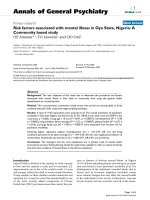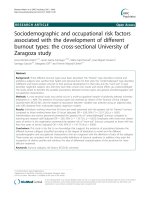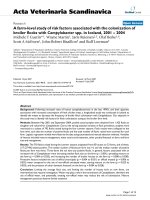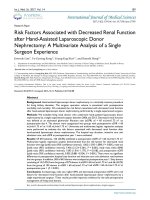Risk factors associated with canine parvovirus disease in dogs: A case-control study
Bạn đang xem bản rút gọn của tài liệu. Xem và tải ngay bản đầy đủ của tài liệu tại đây (419.46 KB, 7 trang )
32
Nong Lam University, Ho Chi Minh City
Risk factors associated with canine parvovirus disease in dogs: A case-control study
Phu H. Doan1∗ , Luyen P. Truong1 , Linh T. K. Tu1 , Minh H. D. Nguyen1 ,
Quynh H. Nguyen1 , Lien T. B. Nguyen1 , Pornchai Pornpanom3 , & Hien T. Le2
2
1
Sub-Department of Veterinary Medicine, Nong Lam University, Gia Lai Campus, Gia Lai, Vietnam
Faculty of Animal Science and Veterinary Medicine, Nong Lam University, Ho Chi Minh City, Vietnam
3
Faculty of Natural Resources, Rajamangala University of Technology Isan, Sakon Nakon Campus,
Sakon Nakhon, Thailand
ARTICLE INFO
ABSTRACT
Research Paper
Canine parvovirus type-2 (CPV-2) is one of the most contagious
viral agents causing acute enteritis in pups with high rate of morbidity and mortality. The study aimed to investigate the risk factors associated with canine parvovirus (CPV) occurrence in dogs
in Ho Chi Minh City, Vietnam. A total number of 132 dogs less
than six months of age were recruited in the study and split into
two groups: ‘CPV diseased dogs’ included 44 (33.3%) dogs positive with canine parvovirus confirmed by rapid immuno-migration
test, and ‘normal dogs’ consisted of 88 (66.7%) healthy dogs. Results indicated that the unvaccinated dogs had 11.76 times more
risk of CPV infection than vaccinated dogs (OR = 11.76, P <
0.001). The risk of CPV in dogs raised with others at the same
age was 5.01 times (OR = 5.01, P = 0.027) higher than those
raised singly. The risk of CPV infection of dogs interacting with
neighbour dogs was 3.13 times (OR = 3.13, P = 0.028) higher
than the dogs having no contact with other dogs living nearby.
Briefly, our study highlights potential factors for CPV disease prevention, especially CPV vaccination is the most important driver
affecting the occurrence of parvovirus in young dogs.
Received: September 15, 2020
Revised: November 26, 2020
Accepted: December 21, 2020
Keywords
Canine parvovirus
Dogs
Ho Chi Minh City
Risk factors
∗
Corresponding author
Doan Hoang Phu
Email:
Cited as: Doan, P. H, Truong, L. P., Tu, L. T. K., Nguyen, M. H. D., Nguyen, Q. H., Nguyen, L.
T. B., Pornpanom, P., & Le, H. T. (2020). Risk factors associated with canine parvovirus disease
in dogs: A case-control study. The Journal of Agriculture and Development 19(6), 32-38.
1. Introduction
aged dogs with clinical signs including bloody foul
smelling diarrhoea, vomiting and severe dehydration (Goddard & Leisewitz, 2010). The infection
is transmitted by fecal-oral route through direct
contact with contaminated feces or exposure to
CPV fomites (Lamm & Rezabek, 2008). Canine
parvovirus type-2 is highly contagious and stable under a variety of environmental conditions
for months to years (Ling et al., 2012). The high
mortality due to CPV was mostly found in unvaccinated dogs and up to 91% in cases without
therapeutic intervention (Brady et al., 2012).
In the 1970s, outbreaks of severe gastroenteritis caused by canine parvovirus type-2 (CPV2) in dogs were first reported in Europe (1976)
and the United States (1978) (Pollock & Coyne,
1993). The emergence of canine parvovirus disease in dogs have been currently spreading worldwide (Decaro & Buonavoglia, 2012). Gastroenteritis and myocarditis are recognized as two common clinical forms of CPV. While myocarditis
is rarely found due to maternal effective immunization protecting pups in early period of life
Previous studies around the world investigated
(Mohammed et al., 2008), gastroenteritis com- the association between CPV infection and facmonly occurs particularly in less than 6-month tors related to dogs’ general information (i.e.,
The Journal of Agriculture and Development 19(6)
www.jad.hcmuaf.edu.vn
33
Nong Lam University, Ho Chi Minh City
age, gender, breed, vaccination status, etc.) (Mohammed et al., 2008; Naveenkumar et al., 2019;
Sharma, 2019), dogs’ clinical information (i.e.,
dehydration, rectal temperature, vomiting, diarrhoea, etc.) (Miranda et al., 2015), dog freeroaming access (Hsu et al., 2003), space and time
of CPV infection (Brady et al., 2012). In Vietnam, since the first cases of CPV were observed in
dogs in 1994 (unpublished data), there have been
subsequent reports on parvovirus infection, which
mostly focused on the evolution of antigenic CPV
(Nakamura et al., 2004), incidence of parvovirus
in dogs (Mai et al., 2018), molecular characterization of CPV (Quynh & Dai, 2014; Hoang et al.,
2019; Vo et al., 2019). There is still little known
about the factors regarding increased occurrence
of CPV infection in dogs in Vietnam. Thus, our
study aimed to investigate risk factors as potential drivers associated with canine parvovirus in
dogs. The results of study will serve to increase
awareness of dog owners in CPV prevention and
support veterinarians in early treatment of CPV
in dogs in Vietnam.
2. Materials and Methods
dogs brought to the clinic. This criterion helped
to define ‘normal dogs’ were truly healthy and
had no infection of parvovirus since the incubation period of CPV in dogs is ranged from 3 - 7
days (Lamm & Rezabek, 2008).
2.2. Detect canine parvovirus
immuno-migration
by
rapid
The test selection was relied on its absolute
sensitivity (96.9%) and specificity (96.9%) in a
good agreement with hemagglutination inhibition
(HI) assay considered as ‘gold standard’ for detecting CPV in dogs (VETSCAN, 2018.). The
principle of the rapid test is to detect specific
epitopes of a soluble antigen of all strains of canine parvovirus shed in diseased dog’s feces by
using Rapid immuno-migration. Samples containing CPV antigen when put into contact with sensitized particles would create a complex which
then migrates along a membrane before captured
on a sensitized reaction zone where the cumulative concentration could result in a clearly visible
purple band. Another purple band located in opposite side of the membrane on the kit is a control
band to ensure the test was performed correctly.
2.1. Study area and dogs’ selection
2.3. Data collection
The study was conducted at a veterinary clinic
located in Thu Duc District, Ho Chi Minh city
from January 2020 to June 2020. Dogs delivered
to the clinic with typically CPV clinical suspicion (i.e., smelly haemorrhagic diarrhea, vomiting, rapid dehydration, lethargy and anorexia)
(Oliveira et al., 2018) and confirmed using Rapid
Immune-migration (Rapid CPV Ag Test Kit,
Zhenrui Biotech Inc., Shenzhen, China) were included in a group named ‘CPV diseased dogs’;
this group was defined as cases in the study. Besides, another group named ‘normal dogs’, defined as controls, was healthy dogs carried for
other services provided at clinic (i.e., vaccine injection, grooming, spa) with the criteria of normal vital signs (body temperature 38 - 39o C,
heart rate 70 - 120 beats/min, respiratory rate 18
- 34 breaths/min) and healthy appearance (moist
nose, pink gums, bright eyes without watering,
smooth and supple skin, glossy coat, agile signs)
(Bukowski & Aiello, 2011). The clinic had a service of weekly calling to dog owners to ask about
pet’s health condition; healthy dogs were defined
in controls were those without any announcement
of CPV disease signs after a week from the date
www.jad.hcmuaf.edu.vn
The dog owners in both groups of cases and
controls were asked to participate in the study
and approve providing their responses to structured questionnaire. The questions focused on
groups of information could be potential risk factors affecting occurrence of parvovirus in dog including: (1) demographic characteristics of dog
owners: age, gender; (2) dog-related information:
age, gender, breed of dogs; and (3) dog-caring
practice: CPV vaccination status, dog-keeping
habits, raised with other dog/s, interaction with
neighbour dog/s. Details of participant information sheet (PIS) and information consent form
(ICF) have been read carefully and signed by all
participants in study.
2.4. Statistical analyses
Risk factor analyses for outcome variable of
CPV status (CPV diseased dogs/ normal dogs)
were carried out by logistic regression. The explanatory variable investigated were: (1) dog’s
owner gender (male/female); (2) dog’s owner age
(years); (3) dog’s gender (male/female); (4) dog’s
The Journal of Agriculture and Development 19(6)
34
Nong Lam University, Ho Chi Minh City
age (months); (5) breed of dog (Vietnamese native/ foreign/ mixed); (6) CPV vaccination status
(yes/no); (7) dog-keeping habit (mostly inside the
house/ freely outside access/ restrictively outside
access); (8) raising with other dog/s (same-aged
dog/ different-aged dog/ no); and (9) interaction
with neighbour dog/s (yes/no/unknown). Stepwise approach was applied to select a final model
of multivariable model. Univariable models were
screened and those with P < 0.20 were kept as
a candidate for final model. Variables of multivariable model with P < 0.05 were considered
as significant factors (risk/protective) associated
with infection of parvovirus in dogs. All statistical analyses were done using R statistical software
(The R, 2020).
spectively (P = 0.005). Study dogs were mostly
kept inside the house, the percentages were 54.6%
and 64.8% in both CPV diseased and normal
group; however, in case group the percentage of
dogs freely outside access was relatively high, accounted for 22.7% (10/44) compared with small
percentage 5.7% (5/88) in control group (P =
0.01). Dogs raised with the same-aged dogs had
morbidity of parvovirus in case group (22.7%)
higher than those in normal group (8.0%) (P =
0.035). Besides, history of interacting with neighbour dog/s between two groups was significantly
different, 50.0% for case group and 33.0% for control group (P = 0.014).
3. Results and Discussion
In the multivariable model, three variables of
CPV vaccination status, raising with other dogs
and interaction with neighbour dogs remained
significant from the univariable models (Table 2).
Unvaccinated dogs had 11.76 times more risk of
getting parvovirus disease than vaccinated ones
(OR = 11.76, P < 0.001). The risk of CPV infection in dogs raised with other same-aged dogs was
5.01 times (OR = 5.01, P = 0.027) higher than
those raised singly. Dogs having interaction with
neighbour dog/s had 3.13 times (OR = 3.13, P =
0.028) increased risk of getting CPV than dogs
without any contact with other nearby dog/s.
Variables of Breed and Dog-keeping habit became
non-significant in final model since they were confounded by variable CPV Vaccination status (χ2
Test, P = 0.001; Fisher’s Test, P = 0.002).
3.1. The selection progress of study dogs
Over study period of 6 months, a total number
of 44 cases of CPV infection were investigated
by the rapid test. In ‘normal dogs’ group, a total number of 107 dogs participated in the study.
However, since all 44 CPV infected dogs were all
less than 6 months old, in order to avoid selection bias, we classified ‘normal dogs’ group and
selected only 88 dogs (out of 107) with less than
6-month age as non-cases or controls for epidemiological analyses. The geographical locations of a
total number of 132 study dogs (44 cases and 88
controls) are presented in Figure 1.
3.2. Descriptive characteristics of dog’s owners and dog-related information
Demographic information of dog’s owners and
dog-related characteristics are described in Table 1. Out of 44 CPV infected dogs, the proportion of dogs injected CPV vaccine was 25.0%
(11/44), whereas 81.8% (72/88) dogs in normal
group had vaccination of CPV (P = 0.005).
More than half of study dogs (50.8%) were foreign breed (i.e., Poodle, Dachshund, Pomeranian,
Rockweiler, Cardigan Welsh Corgi, Pekingese,
etc.), the remaining dogs were equal (∼25%) in
Vietnamese native breed (Indochina dingo, Phu
Quoc ridgeback) and mixed breed (Indochina
dingo cross-bred with foreign breed); the highest
morbidity of CPV infection was in Vietnamese
native breed (40.9%), while in foreign and mixed
breed the morbidity were 36.4% and 22.7% re-
The Journal of Agriculture and Development 19(6)
3.3. Risk factor analyses
3.4. Discussion
To our knowledge, this is the first study investing of factors associated with CPV infection
in Vietnamese dogs. We conducted a case-control
study with case group was identified using the
rapid antigen detection test, and control group
was defined based on vital and healthy signs at
the time dogs delivered to the clinic and without
any announcement of getting disease a week afterward. Control group was therefore appropriate
and comparable to the case group in estimates of
expected exposures in our study.
In our study, all participants were raising less
than 6-month dogs in both groups. The selection
bias was considered by exclusion of dogs higher
than 6 months of age to get truly representative
population from which the cases might have expowww.jad.hcmuaf.edu.vn
www.jad.hcmuaf.edu.vn
∗
Wilcoxon Test,
∗∗
χ2 Test,
∗∗∗
Fisher’s Test.
Interaction with neighbour dog/s∗∗ (%)
Raising with other dogs∗∗ (%)
Dog-keeping habit∗∗∗ (%)
CPV vaccination status∗∗ (%)
Breed of dogs∗∗ (%)
Dog’s gender∗∗ (%)
Dog’s age∗∗ (%)
Owner’s gender∗∗ (%)
Owner’s age∗ (Median [IQR])
Characteristics
Male
Female
≤ 3 months
> 3 months
Male
Female
Vietnamese native
Foreign
Mixed
Yes
No
Mostly inside the house
Freely outside access
Restrictively outside access
Yes (same-aged dog/s)
Yes (different-aged dog/s)
No
Yes
No
Unknown
CPV diseased dogs
(n = 44)
35.0 [29.8-40.0]
23 (52.3%)
21 (47.7%)
30 (68.2%)
14 (31.8%)
29 (65.9%)
15 (34.1%)
18 (40.9%)
16 (36.4%)
10 (22.7%)
11 (25.0%)
33 (75.0%)
24 (54.6%)
10 (22.7%)
10 (22.7%)
10 (22.7%)
12 (27.3%)
22 (50.0%)
22 (50.0%)
15 (34.1%)
7 (15.9%)
Table 1. Descriptive characteristics of dog’s owners and dog-related information
Normal dogs
(n = 88)
33.5 [28.0-39.0]
34 (38.6%)
54 (61.4%)
52 (59.1%)
36 (40.9%)
50 (56.8%)
38 (43.2%)
14 (15.9%)
51 (58.0%)
23 (26.1%)
72 (81.8%)
16 (18.2%)
57 (64.8%)
5 (5.7%)
26 (29.5%)
7 (8.0%)
21 (23.9%)
60 (68.1%)
29 (33.0%)
57 (64.8%)
2 (2.2%)
0.014
0.035
0.010
0.005
0.005
0.415
0.409
0.192
0.542
P-value
Nong Lam University, Ho Chi Minh City
35
The Journal of Agriculture and Development 19(6)
36
Nong Lam University, Ho Chi Minh City
Figure 1. Map of study area in Ho Chi Minh City and participants’ geographical locations. The geographical
coordinates were collected on Google Map based on the exact addresses provided by participants. Vector
layers of quantum geographic information system (QGIS 2.14) were applied to plot the coordinates on the
map.
sure (Lamorfe, 2020), but still maintain the statistical power by getting more than one control
for every case (the ratio of 2 controls: 1 case in our
study) (Lewallen & Courtright, 1998). Besides,
participants were raising dogs within duration of
up to 6 months, the time was supposed not too
long from their memories when they responded
to the questionnaire. This helped to reduce recall bias, a common problem in case-control study
(Boone et al., 2012).
Our finding indicated the critical importance
of vaccination in CPV prevention in dogs. This
was consistent with previous studies conducted
in Portugal and Nigeria (Mohammed et al., 2008;
Miranda et al., 2015) where unvaccinated dogs
had a risk of infecting CPV higher than dogs
injected CPV vaccine 2.00 and 25.14 times, respectively. In addition, exposure of naive dogs
to the feces of CPV-2 infected animal or fomites
was also important risk factors of CPV infection
(Hsu et al., 2003). Our study found the increased
incidence of CPV in dogs who had interactions
The Journal of Agriculture and Development 19(6)
with other neighbour dogs as well as lived with
other same-aged dogs. Therefore, the recommendations for inhibition of dog free outside access
and cleaning and disinfection of housing, bedding
and other materials in contact with affected animals should be thoroughly performed on a regular
basis (Lamm & Rezabek, 2008).
Generally, in Vietnam core vaccination of a
multivalent modified-live viral (MLV) vaccine is
recommended at 8th - 10th weeks of age, and
an additional booster vaccination at 12th - 14th
weeks, then a booster vaccination is administered
in subsequent years. There were 11 cases of clinical illness in vaccinated dogs in our study with
the age median of these dogs was 2.5 months
[IQR 1.5-3.0] and all were the first vaccinations.
There has been shown that overwhelming viral
dose while antibodies yielded from only one shot
of vaccination were inadequate to protect dogs
(Lamm & Rezabek, 2008). In addition, the susceptibility for CPV infection in pups actually begins 2-3 weeks before the waning of maternal anwww.jad.hcmuaf.edu.vn
37
0.028
0.251
(1.13 - 8.68)
(2.91 - 75.72)
0.009
0.241
2.88
13.30
(1.30 - 6.38)
(2.50 - 70.74)
www.jad.hcmuaf.edu.vn
Legend: The tables illustrates only significant variables in univariable models, considered as candidates for multivariable model. ∗ Model intercept = -2.923, SE = 0.526.
0.027
0.281
(1.20 - 20.98)
(0.60 - 5.70)
5.01
1.85
0.134
0.312
(1.32 - 11.50)
(0.68 - 3.69)
3.90
1.56
0.009
0.839
(1.47 - 15.38)
(0.38 - 2.18)
4.75
0.91
< 0.001
(5.65 - 32.26)
13.50
0.002
0.492
(1.67 - 10.00)
(0.54 - 3.52)
Breed (Baseline=Foreign)
Vietnamese native
Mixed breed
CPV vaccination status (Baseline=Yes)
No
Dog-keeping habit (Baseline = mostly inside the house)
Freely outside access
Restrictively outside access
Raising with other dogs (Baseline = No)
Yes - same aged dog/s
Yes - different aged dog/s
Interaction with neighbour dog/s (Baseline = No)
Yes
Unknown
4.10
1.39
OR
3.13
20.93
< 0.001
(4.55 - 30.38)
11.76
Multivariable Model∗
(95% CI)
P-value
Univariable Model
OR (95% CI)
P-value
Variables
Table 2. Logistic regression models investigating risk factors associated with occurrence of canine parvovirus in dogs
Nong Lam University, Ho Chi Minh City
tibodies at 8-12 weeks of age (Nandi & Kumar,
2010), the neutralization of early viral vaccine
by maternal antibodies could be a reason interpreting for these cases. Besides, the possibility
of CPV infection with variant wide-type strains
could be eliminated since the demonstration of
cross-protection among virus types by multivalent modified-live viral vaccine were reported in
previous studies (Truyen, 2006; Glover et al.,
2012).
Our study had several limitations: We conducted convenience sampling relied on dogs
delievered to the clinic within six months, spatial and temporal data were not fully collected
to have a comprehensive description of risks associated with CPV in dogs. Since a lack of information about the time of vaccination in both
study dogs and their mothers, the effects of vaccination on CPV disease in dogs, particularly vaccinated dogs, were unable to precisely interpret.
However, to a certain extent, we believe that our
findings can be extrapolated to other dog populations raised in other areas in Ho Chi Minh city,
Vietnam.
4. Conclusions
Our findings highlight that improving the
awareness in CPV vaccination and caring practice of dog owners are the crucial factors to reduce
the risks of CPV infection in dogs. There is a need
for follow-up studies on spatio-temporal epidemiology of CPV to have problem-solving approaches
towards canine parvovirus, one of the most currently popular diseases in dogs in Vietnam.
Acknowledgements
The authors would like to thank all dog owners participated in the study, Pet World veterinary clinic and Faculty of Animal Science and
Veterinary Medicine, Nong Lam University, Ho
Chi Minh City for all their help and support.
Conflict of interest declaration
The authors declare no conflict of interest.
References
Boone, D., Halligan, S., Mallett, S., Taylor, S. A., & Altman, D. G. (2012). Systematic review: Bias in imaging
studies - the effect of manipulating clinical context, re-
The Journal of Agriculture and Development 19(6)
38
Nong Lam University, Ho Chi Minh City
call bias and reporting intensity. European Radiology
22(3), 495-505.
Brady, S., Norris, J. M., Kelman, M., & Ward, M. P.
(2012). Canine parvovirus in Australia: The role of
socio-economic factors in disease clusters. The Veterinary Journal 193(2), 522-528.
Bukowski, J. A., & Aiello, S. (2011). Description
and physical characteristics of dogs—Dog owners—Veterinary manual. Retrieved September 15,
2020, from />
Mohammed, J. G., Ogbe, A., Zwandor, N., & Umoh, J.
(2008). Risk factors associated with canine parvovirus
enteritis in vom and environs. Animal Research International 2(3), 366-368.
Nakamura, M., Tohya, Y., Miyazawa, T., Mochizuki, M.,
Phung, H. T. T., Nguyen, N. H., Huynh, L. M. T.,
Nguyen, L. T., Nguyen, P. N., Nguyen, P. V., Nguyen,
N. P. T., & Akashi, H. (2004). A novel antigenic variant
of canine parvovirus from a Vietnamese dog. Archives
of Virology 149(11), 2261-2269.
Nandi, S., & Kumar, M. (2010). Canine parvovirus: Current perspective. Indian Journal of Virology 21(1), 3144.
Decaro, N., & Buonavoglia, C. (2012). Canine parvovirus
- A review of epidemiological and diagnostic aspects,
with emphasis on type 2c. Veterinary Microbiology
155(1), 1-12.
Naveenkumar, V., Bharathi, M. V., Porteen, K., Selvaraju, G., & Vijayarani, K. (2019). Factors associated with the occurrence of canine parvoviral enteritis
in dogs. Journal of Animal Research 9(6), 893-896.
Glover, S., Anderson, C., Piontkowski, M., & Ng, T.
(2012). Canine parvovirus (CPV) type 2b vaccine protects puppies with maternal antibodies to CPV when
challenged with virulent CPV-2c virus. Journal of Applied Research in Veterinary Medicine 10(3), 217-224.
Oliveira, P. S. B. de, Cargnelutti, J. F., Masuda, E. K.,
Fighera, R. A., Kommers, G. D., Silva, M. C. da,
Weiblen, R., & Flores, E. F. (2018). Epidemiological,
clinical and pathological features of canine parvovirus
2c infection in dogs from southern Brazil. Pesquisa
Veterin´
aria Brasileira 38(1), 113-118.
Goddard, A., & Leisewitz, A. L. (2010). Canine parvovirus. Veterinary Clinics of North America: Small
Animal Practice 40(6), 1041-1053.
Hoang, M., Lin, W. H., Le, V. P., Nga, B. T. T., Chiou,
M. T., & Lin, C. N. (2019). Molecular epidemiology of
canine parvovirus type 2 in Vietnam from November
2016 to February 2018. Virology Journal 16(1), 52.
Hsu, Y., Liu Severinghaus, L., & Serpell, J. A. (2003).
Dog keeping in Taiwan: Its contribution to the problem of free-roaming dogs. Journal of Applied Animal
Welfare Science 6(1), 1-23.
Lamm, C. G., & Rezabek, G. B. (2008). Parvovirus infection in domestic companion animals. Veterinary Clinics of North America: Small Animal Practice 38(4),
837-850.
Lamorfe,
W.
W.
(2020).
Selection
Retrieved
September
15,
2020,
Bias/EP713 Bias2.html.
Bias.
from
Lewallen, S., & Courtright, P. (1998). Epidemiology in
practice: Case-control studies. Community Eye Health
11(28), 57-58.
Ling, M., Norris, J. M., Kelman, M., & Ward, M. P.
(2012). Risk factors for death from canine parvoviralrelated disease in Australia. Veterinary Microbiology
158(3-4), 280-290.
Mai, N. T. Y., Bich, T. N., Khanh, N. P., Phuthavong, K.,
& Thanh, T. V. (2018). The incidence of canine parvoviral enteritis in the veterinary clinic of Tien Giang,
Dong Thap province and Can Tho city. Can Tho University Journal of Science 54(Agriculture), 136-142.
Pollock, R. V. H., & Coyne, M. J. (1993). Canine parvovirus. Veterinary Clinics of North America: Small
Animal Practice 23, 555-568.
Quynh, N. H., & Dai, V. T. (2014). Dectection
Canine Parvovirus in dogs by PCR Technique. Retrieved September 1, 2018, from
/>Sharma, S., Dhar, P., & Sharma, M. (2019). Study of
different risk factors for canine parvovirus infection by
haemagglutination assay. Journal of Animal Research
9(5), 735-739.
The R. (2020). The R Project for Statistical Computing. (n.d.). Retrieved December 10, 2020, from
/>Truyen, U. (2006). Evolution of canine parvovirus—A
need for new vaccines? Veterinary Microbiology
117(1), 9-13.
VETSCAN.
(2018).
A
truth
of
accuracy
parvo. Retrieved December 10, 2020, from
/>Accuracy%20Parvo.pdf.
Vo, H. V., Nguyen, Y. T., Dao, A. L., Hoang, M., Bui,
D. T. A, Bui, N. T. T., Nguyen., L. T., & Phan, L.
V. (2019). Molecular characterization of canine parvovirus type 2 isolated from dogs in Ha Noi. Vietnam
Journal of Agricultural Sciences 17(2), 100-107.
Miranda, C., Carvalheira, J., Parrish, C. R., & Thompson, G. (2015). Factors affecting the occurrence of
canine parvovirus in dogs. Veterinary Microbiology
180(1-2), 59-64.
The Journal of Agriculture and Development 19(6)
www.jad.hcmuaf.edu.vn









